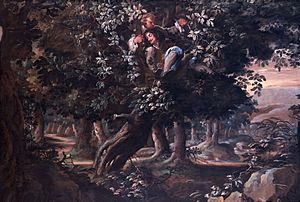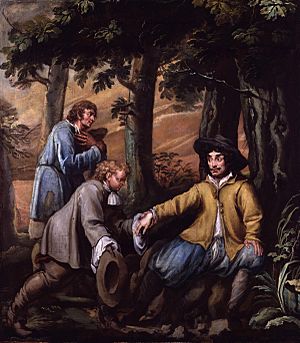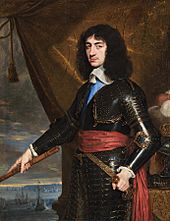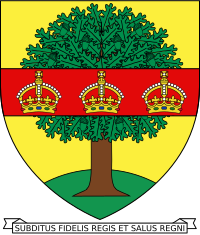William Careless facts for kids
Quick facts for kids
William Careless, later Carlos
|
|
|---|---|

King Charles II and Colonel William Careless in the Royal Oak by Isaac Fuller
|
|
| Born | c. 1610 Broom Hall, Brewood, Staffordshire |
| Died | 1689 London |
| Buried |
St. Mary the Virgin and St. Chad churchyard, Brewood.
|
| Allegiance | Royalist |
| Rank | Colonel |
| Commands held | A troop and later a regiment of cavalry, the garrison of Tong Castle, officer of the Royal Guard, |
| Battles/wars | English Civil War, Bolton Massacre, Battle of Marston Moor, Battle of Worcester, Battle of the Dunes (1658) |
Colonel William Careless was a brave officer who fought for the King during the English Civil War. He was born around 1610 in Brewood, Staffordshire. William Careless is best known for helping King Charles II hide in a special oak tree after a big battle. The King later changed William's last name to Carlos, which means Charles in Spanish, to honor him. William Carlos passed away in 1689.
Contents
William's Early Military Career
Fighting in the First Civil War
William Careless came from a Catholic family who supported the King. When the war started in 1642, William gathered a group of horse soldiers to fight for King Charles I. He became a captain in a regiment mostly made up of Catholic men from his area.
He was in charge of the King's soldiers at Lapley House in 1643. In April 1644, he became the leader of Tong Castle in Shropshire. William also fought in major battles like the Bolton Massacre and the Battle of Marston Moor in 1644. After a big loss for the King's side at Marston Moor, William was captured by the Parliamentarian forces near Wolverhampton. He was held as a prisoner in Stafford.
After being set free, William served in Ireland and lived in the Netherlands for a while. He even became an officer in the Spanish army. He returned to England around 1650 and soon joined the King's cause again.
The 1651 Campaign and the Royal Oak

After King Charles I was executed, his son, Charles II, came to England with an army. William Careless joined him with his own group of horse soldiers. He fought as a major at the Battle of Worcester. The King's army lost very badly. William fought bravely until the end, helping King Charles escape the city. He and a few others made daring charges against many enemy soldiers. Their actions allowed King Charles to get away safely.
After the defeat, King Charles hid at Boscobel House. There, he met Major Careless. William, who knew the area well, thought the house might not be safe. He suggested that the King hide in a large oak tree in the nearby woods. On September 6, 1651, the King and William climbed into the tree with some food and drink. Parliamentarian soldiers searched the woods, but they did not find them. The King was very tired and even slept in the tree, with William helping to keep him from falling.
That night, they hid in secret rooms called "priest holes" in Boscobel House. The next day, William killed a sheep with his dagger, and the King himself cooked the meat. Since William was well-known in the area, he left the King later that day to avoid drawing attention to him.
A special locket from that time, with a tiny picture of William Careless, is now in the Victoria and Albert Museum in London. It has a poem inside that praises William for helping King Charles escape.
Life in Exile and Return
Living Abroad
William Careless managed to escape England on his own and went to France. He was the first person to tell King Charles's sister, Mary, Princess of Orange, that her brother was safe.
In 1656, William Careless, now a colonel, was a captain in the King's Royal Regiment of Guards. This regiment is now known as the Grenadier Guards. In 1658, he was given a special coat of arms (a family symbol) by King Charles. This symbol, under the name Carlos, included an oak tree and three crowns, representing the three kingdoms of Britain.
William fought with his regiment at the Battle of the Dunes (1658) near Dunkirk. His regiment stood strong even when other regiments around them fled. William was captured in this battle but was soon released.
Coming Back to England
William returned to England with King Charles II in 1660. After the King was back on the throne, William was given special rights and jobs. For example, he received money from taxes on hay and straw brought into London. He was also considered for a special award called the Order of the Royal Oak. This award was meant for people who had helped the King during difficult times. However, King Charles decided not to create this new order because he thought it might cause problems.
In 1666, William Careless became a Gentleman of the Privy Chamber. This meant he could carry out the King's spoken orders without needing written proof. William often helped his friends and neighbors who had also helped King Charles escape.
In 1678, William and other Catholics who had helped the King were made exempt from laws against Catholics. He was very loyal to King Charles's successor, James II, and received money from the King in 1687.
William Careless was known by different ranks, including captain, major, and colonel. He was a major at the Battle of Worcester but was promoted to colonel by 1656. He died in London and was buried in his hometown of Brewood on May 28, 1689. There is a memorial to him in the church of St Mary the Virgin and St Chad in Brewood.
William's Family
William Careless married the sister of Sampson Fox, one of his soldiers. William had two sons: William, who became a priest, and Thomas. He also adopted his nephew, Edward Carlos. His son William was with him in exile and fought at Worcester. William Jr. later became a Jesuit priest.
The Careless family of Brewood lost most of their land in the 1720s. This happened when Charles Carlos, the grandson of Colonel William Careless, spent all the family's money.
William's Legacy
In 2013, a special plaque honoring William Careless (as William Carlos) was placed at the base of a statue of Charles II in London.
Oak Apple Day was a national holiday celebrated in England on May 29 for many years. It remembered the return of the English monarchy. The oak tree symbol in this celebration refers to William Careless's clever idea of hiding King Charles II in the Royal Oak tree.
A special medal was made to remember those who helped King Charles escape. It listed "COL . CARLES" among the main helpers.
While some families who helped King Charles still receive payments today, the payments given to William Careless's descendants were stopped by the British government in the 1800s and early 1900s.
William in Stories
William Careless is an important character in the novel Boscobel or the Royal Oak: A Tale of the Year 1651, written by William Harrison Ainsworth in 1871. He also appears as William Carlis in the historical novel Royal Escape (1938) by Georgette Heyer.





